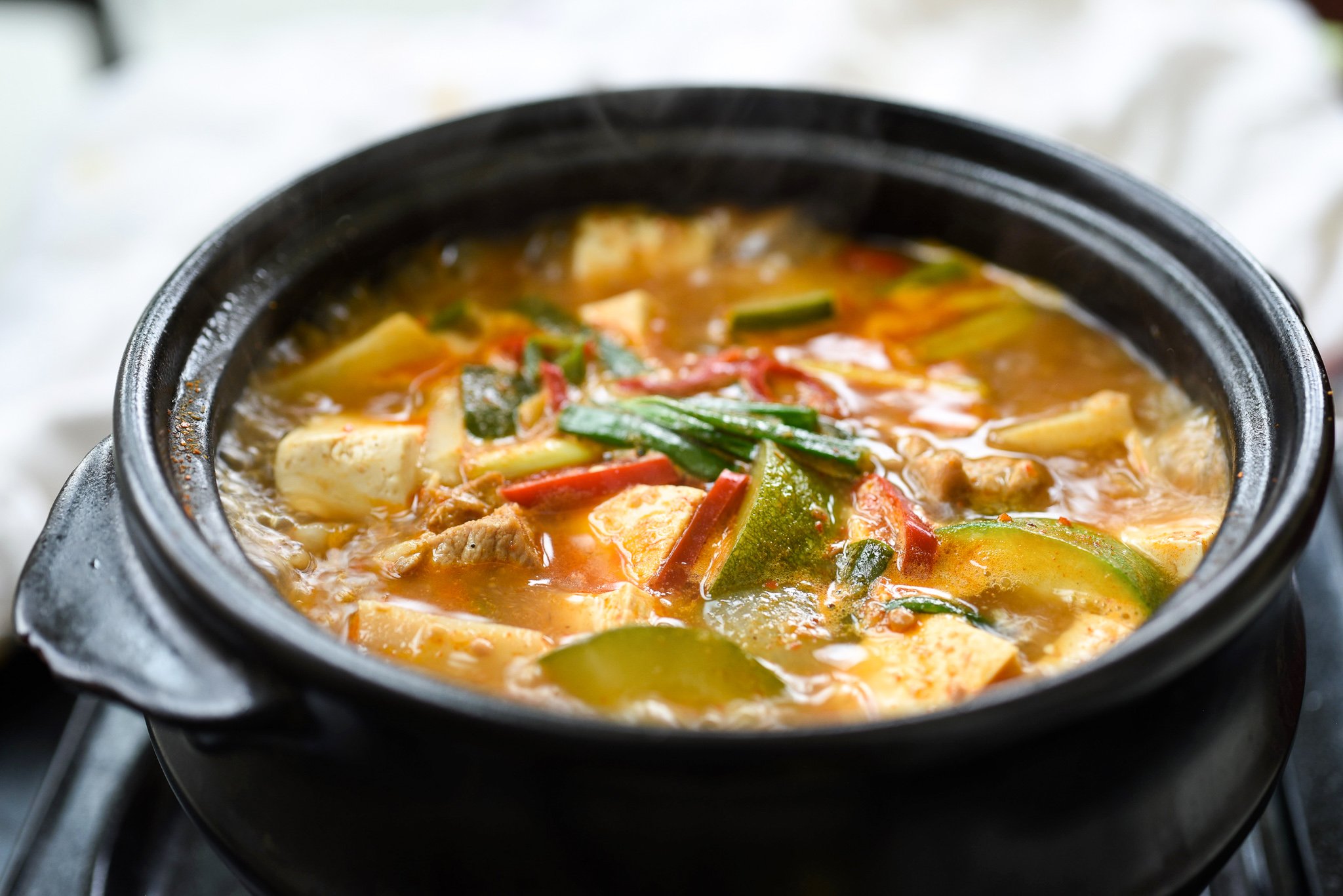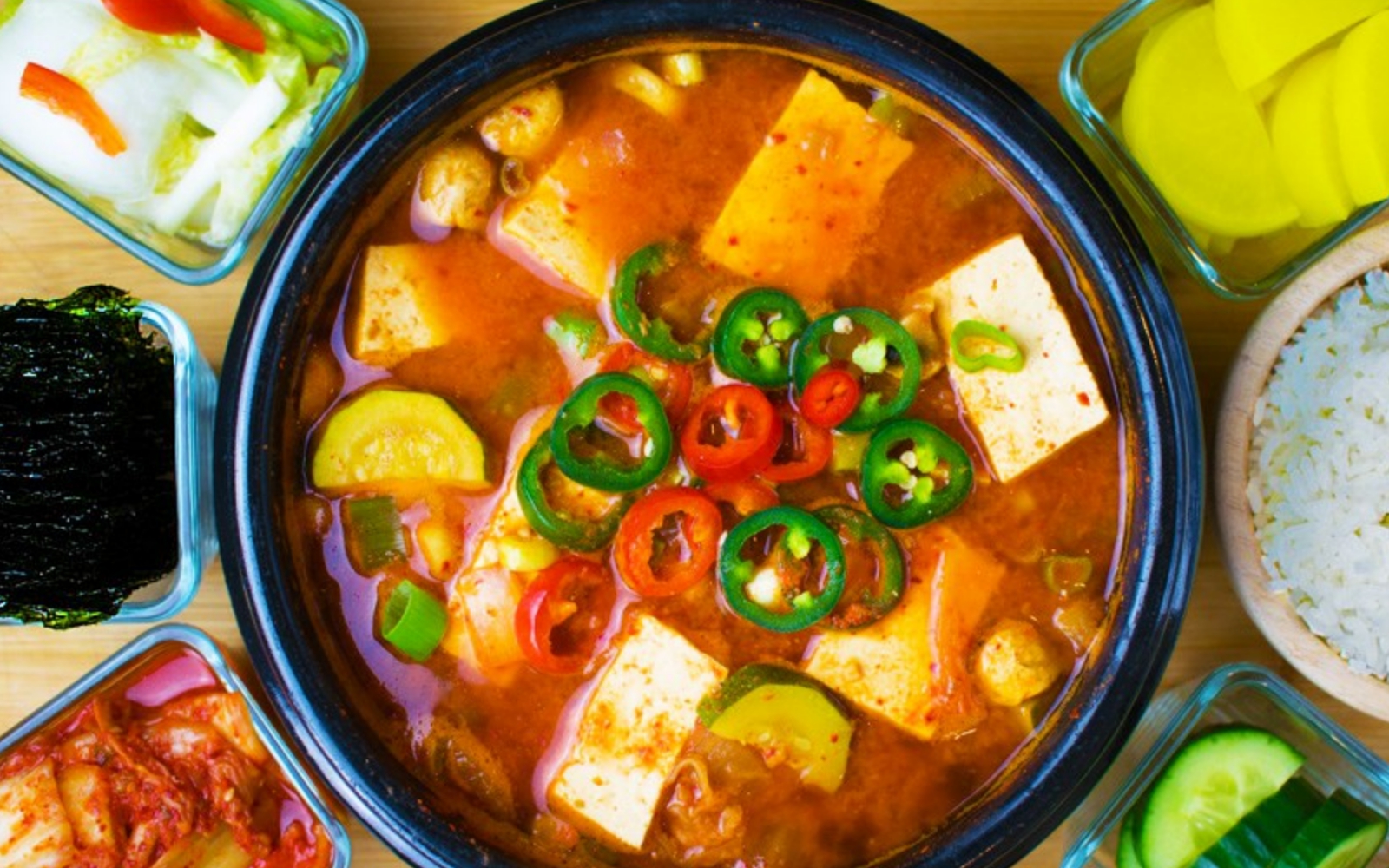Embark on a culinary journey to the heart of Korean cuisine, where the beloved soybean paste stew reigns supreme. This delectable dish, also known as Doenjang Jjigae, is a harmonious blend of savory, spicy, and comforting flavors that will tantalize your taste buds and warm your soul.
With its origins dating back centuries, soybean paste stew has become an integral part of Korean culinary culture. It is a versatile dish that can be enjoyed on any occasion, from cozy family dinners to festive gatherings. Its simplicity and adaptability have made it a staple in Korean homes, passed down through generations.
Ingredients
The foundation of a classic soybean paste stew lies in a harmonious blend of essential ingredients.
Commonly, you’ll find:
- Soybean paste: The star of the show, providing a rich, savory base.
- Pork belly: Tender and flavorful, adding depth and umami.
- Vegetables: A colorful medley of onions, potatoes, and zucchini, contributing sweetness and texture.
- Green onions: A vibrant garnish, adding freshness and pungency.
Variations
While the core ingredients remain consistent, variations abound based on regional preferences and personal tastes.
- Seafood: Coastal regions often incorporate shrimp, clams, or mussels for a briny twist.
- Vegetables: Carrots, bell peppers, and mushrooms are popular additions, adding color and nutritional value.
- Spices: A touch of ginger, garlic, or chili flakes can enhance the stew’s flavor profile.
Preparation
Preparing soybean paste stew involves a series of steps to achieve the optimal texture and flavor. These steps include marinating the ingredients, browning them for depth of flavor, and simmering them in a savory broth to create a rich and complex dish.
Marinating the Ingredients
To enhance the flavors of the stew, the ingredients are first marinated in a mixture of soybean paste, gochujang (Korean chili paste), and other seasonings. This marinade not only tenderizes the meat but also infuses it with a rich, savory taste.
The marinade is typically left on the ingredients for several hours or overnight to allow for maximum flavor absorption.
Browning the Ingredients
After marinating, the ingredients are browned in a large pot or skillet. This process caramelizes the sugars in the ingredients, creating a deep, flavorful crust. The browning also helps to seal in the juices and prevent the ingredients from becoming dry during the simmering process.
Simmering the Stew
The browned ingredients are then added to a broth made from water, soy sauce, and other seasonings. The stew is brought to a boil and then reduced to a simmer. The stew is simmered for several hours, or until the meat is tender and the flavors have melded together.
During the simmering process, the stew is occasionally stirred to prevent the ingredients from sticking to the bottom of the pot.
Seasoning
Seasoning plays a crucial role in enhancing the flavor of soybean paste stew. The key seasonings used are soy sauce, gochujang, and a variety of others.
Soy sauce adds saltiness and umami, while gochujang contributes spiciness, sweetness, and a characteristic red color. Other seasonings like garlic, ginger, and sesame oil add depth and complexity to the stew’s flavor profile.
Adjusting Seasoning to Taste
Adjusting the seasoning to your preference is essential. Start by adding the seasonings gradually, tasting and adjusting as you go. Consider the following:
- Saltiness: Soy sauce is the primary source of saltiness. Add it sparingly and taste before adding more.
- Spiciness: Gochujang provides the heat. Adjust the amount based on your desired spice level.
- Umami: Soy sauce and gochujang both contribute umami, a savory flavor. If you prefer a more intense umami, add a small amount of anchovy sauce or dried anchovies.
- Sweetness: A touch of sweetness can balance the saltiness and spiciness. Consider adding a teaspoon of sugar or honey.
Variations
Soybean paste stew, a staple in Korean cuisine, boasts diverse regional variations that showcase the unique culinary traditions and flavors of different provinces. Each variation exhibits distinct characteristics in terms of ingredients, cooking methods, and presentation.
One notable variation is the spicy and robust Jeolla-do soybean paste stew , originating from the southwestern region of Korea. This version is characterized by its generous use of gochujang (Korean chili paste), resulting in a vibrant red color and a fiery taste.
It often incorporates ingredients like pork belly, potatoes, onions, and kimchi for added depth and texture.
In contrast, the Chungcheong-do soybean paste stew , hailing from the central region, is known for its milder flavor and a more refined presentation. It typically includes a variety of vegetables, such as zucchini, carrots, and mushrooms, and often features seafood like clams or oysters for a delicate touch.
The Gyeongsang-do soybean paste stew , from the southeastern region, is another popular variation. It is distinguished by its use of saeujeot (salted shrimp paste), which imparts a unique umami flavor. This version often includes ingredients like squid, mussels, and vegetables like cabbage and radish.
These regional variations exemplify the diverse culinary heritage of Korea and offer a glimpse into the distinct flavors and preferences of different provinces. Whether you prefer the spicy kick of Jeolla-do stew, the subtle elegance of Chungcheong-do stew, or the briny umami of Gyeongsang-do stew, there is a soybean paste stew variation to satisfy every palate.
Serving

Soybean paste stew is a versatile dish that can be enjoyed in various settings. It is typically served hot, either as a main course or a side dish.
The stew is often accompanied by rice, which helps to balance the savory and slightly spicy flavors. Other popular side dishes include kimchi, pickled vegetables, and steamed greens.
Presentation
To enhance the presentation of soybean paste stew, consider the following tips:
- Garnish the stew with green onions, sesame seeds, or a drizzle of sesame oil.
- Serve the stew in a heated earthenware or ceramic pot to retain its warmth.
- Arrange the accompaniments and side dishes around the stew in a visually appealing manner.
Nutritional Value

Soybean paste stew is a nutritious dish that offers a wealth of health benefits. Its main ingredients, soybeans, are a rich source of plant-based protein, dietary fiber, and essential vitamins and minerals.
One serving of soybean paste stew (approximately 2 cups) contains approximately 200 calories and provides:
- Protein: 15 grams
- Fiber: 10 grams
- Iron: 10% of the Daily Value (DV)
- Calcium: 15% of the DV
- Vitamin C: 10% of the DV
Last Recap
Whether you are a seasoned cook or a novice in the kitchen, creating a delectable soybean paste stew is a rewarding experience. By following the steps Artikeld above and experimenting with variations, you can craft a dish that is uniquely yours.
So gather your ingredients, embrace the culinary traditions of Korea, and let the flavors of soybean paste stew transport you to a realm of culinary delight.
FAQ Section
Can I substitute other types of miso paste for soybean paste?
While miso paste can be used as a general substitute for soybean paste, it will impart a slightly different flavor profile. Miso paste is typically sweeter and less salty than soybean paste, so you may need to adjust the seasoning accordingly.
How do I store leftover soybean paste stew?
Soybean paste stew can be stored in an airtight container in the refrigerator for up to 3 days. When reheating, bring the stew to a gentle simmer over medium heat, stirring occasionally to prevent burning.
What are some common variations of soybean paste stew?
There are many regional variations of soybean paste stew, each with its own unique ingredients and flavors. Some popular variations include:
